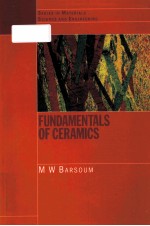

FUNDAMENTALS OF CERAMICSPDF电子书下载
- 电子书积分:18 积分如何计算积分?
- 作 者:
- 出 版 社:TAYLOR & FRANCIS GROUP
- 出版年份:2003
- ISBN:0750309024
- 页数:604 页
Chapter 1: Introduction 1
1.1 Introduction 1
1.2 Definition of Ceramics 2
1.3 Elementary Crystallography 4
1.4 Ceramic Microstructures 6
1.5 Traditional Versus Advanced Ceramics 7
1.6 General Characteristics of Ceramics 7
1.7 Applications 8
1.8 The Future 10
Problems 11
Additional Reading 12
Chapter 2: Bonding in Ceramics 13
2.1 Introduction 13
2.2 Structure of Atoms 14
2.3 Ionic Versus Covalent Bonding 23
2.4 Ionic Bonding 25
2.5 Ionically Bonded Solids 28
2.6 Covalent Bond Formation 33
2.7 Covalently Bonded Solids 37
2.8 Band Theory of Solids 38
2.9 Summary 47
Appendix 2A: Kinetic Energy of Free Electrons 47
Problems 48
Additional Reading 51
Chapter 3: Structure of Ceramics 52
3.1 Introduction 52
3.2 Ceramic Structures 54
3.3 Binary Ionic Compounds 59
3.4 Composite Crystal Structures 65
3.5 Structure of Covalent Ceramics 67
3.6 Structure of Silicates 70
3.7 Lattice Parameters and Density 75
3.8 Summary 79
Appendix 3A:Ionic Radii 80
Problems 84
Additional Reading 87
Chapter 4: Effect of Chemical Forces on Physical Properties 88
4.1 Introduction 88
4.2 Melting Points 88
4.3 Thermal Expansion 94
4.4 Young's Modulus and the Strength of Perfect Solids 99
4.5 Surface Energy 102
4.6 Summary 106
Problems 106
Additional Reading 109
Chapter 5:Thermodynamic and Kinetic Considerations 110
5.1 Introduction 110
5.2 Free Energy 111
5.3 Chemical Equilibrium and the Mass Action Expression 122
5.4 Chemical Stability Domains 123
5.5 Electrochemical Potentials 126
5.6 Charged Interfaces, Double Layers, and Debye Lengths 127
5.7 Gibbs-Duhem Relation for Binary Oxides 129
5.8 Kinetic Considerations 131
5.9 Summary 133
Appendix 5A: Derivation of Eq. (5.27) 133
Problems 134
Additional Reading 135
Chapter 6: Defects in Ceramics 137
6.1 Introduction 137
6.2 Point Defects 138
6.3 Linear Defects 166
6.4 Planar Defects 168
6.5 Summary 170
Problems 171
Additional Reading 174
Chapter 7: Diffuson and Electrical Conductivity 175
7.1 Introduction 175
7.2 Diffusion 176
7.3 Electrical Conductivity 192
7.4 Am bipolar Diffusion 212
7.5 Relationships Between Self-, Tracer, Chemical, Ambipolar,and Defect Diffusion Coefficients 224
7.6 Summary 227
Appendix 7A: Relationship Between Fick's First Law and Eq. (7.30) 229
Appendix 7B: Effective Mass and Density of States 230
Appendix 7C: Derivation of Eq. (7.79) 232
Appendix 7D: Derivation of Eq. (7.92) 233
Problems 234
Additional Reading 241
Chapter 8: Phase Equilibria 242
8.1 Introduction 242
8.2 Phase Rule 243
8.3 One-Component Systems 244
8.4 Binary Systems 247
8.5 Ternary Systems 255
8.6 Free-Energy Composition and Temperature Diagrams 257
8.7 Summary 262
Problems 263
Additional Reading 264
Chapter 9: Formation, Structure, and Properties of Glasses 265
9.1 Introduction 265
9.2 Glass Formation 266
9.3 Glass Structure 280
9.4 Glass Properties 283
9.5 Glass-Ceramics 293
9.6 Summary 296
Appendix 9A: Derivation of Eq. (9.7) 297
Problems 297
Additional Reading 300
Chapter 10: Sintering and Grain Growth 302
10.1 Introduction 302
10.2 Solid-State Sintering 304
10.4 Liquid-Phase Sintering 337
10.5 Hot Pressing and Hot Isostatic Pressing 343
10.6 Summary 345
Appendix 10A: Derivation of the Gibbs-Thompson Equation 346
Appendix 10B: Radii of Curvature 346
Appendix 10C: Derivation of Eq. (10.20) 347
Appendix 10D: Derivation of Eq. (10.22) 349
Problems 350
Additional Reading 354
Chapter 11: Mechanical Properties: Fast Fracture 356
11.1 Introduction 356
11.2 Fracture Toughness 358
11.3 Strength of Ceramics 373
11.4 Toughening Mechanisms 380
11.5 Designing With Ceramics 387
11.6 Summary 394
Problems 395
Additional Reading 399
Chapter 12: Creep, Subcritical Crack Growth, and Fatigue 400
12.1 Introduction 400
12.2 Creep 401
12.3 Subcritical Crack Growth 415
12.4 Fatigue of Ceramics 422
12.5 Lifetime Predictions 425
12.6 Summary 432
Appendix 12A: Derivation of Eq. (12.24) 433
Problems 435
Additional Reading 440
Chapter 13: Thermal Properties 442
13.1 Introduction 442
13.2 Thermal Stresses 443
13.3 Thermal Shock 447
13.4 Spontaneous Microcracking of Ceramics 452
13.5 Thermal Tempering of Glass 456
13.6 Thermal Conductivity 458
13.7 Summary 460
Problems 461
Additional Reading 464
Chapter 14: Dielectric Properties 465
14.1 Introduction 465
14.2 Basic Theory 466
14.3 Equivalent Circuit Description of Linear Dielectrics 471
14.4 Polarization Mechanisms 476
14.5 Dielectric Loss 492
14.6 Dielectric Breakdown 494
14.7 Capacitors and Insulators 494
14.8 Summary 497
Appendix 14A: Local Electric Field 498
Problems 499
Additional Reading 505
Chapter 15: Magnetic and Nonlinear Dielectric Properties 507
15.1 Introduction 507
15.2 Basic Theory 508
15.3 Microscopic Theory 514
15.4 Para-, Ferro-, Antiferro-, and Ferrimagnetism 519
15.5 Magnetic Domains and the Hysteresis Curve 525
15.6 Magnetic Ceramics and their Applications 529
15.7 Piezo-and Ferroelectric Ceramics 537
15.8 Summary 547
Appendix 15A: Orbital Magnetic Quantum Number 548
Problems 549
Additional Reading 551
Chapter 16: Optical Properties 553
16.1 Introduction 553
16.2 Basic Principles 555
16.3 Absorption and Transmission 565
16.4 Scattering and Opacity 573
16.5 Fiber Optics and Optical Communication 576
16.6 Summary 580
Appendix 16A: Coherence 581
Appendix 16B: Assumptions Made in Deriving Eq. (16.24) 581
Problems 582
Additional Reading 587
Index 589
- 《IAF群体引导手册 来自引导界顶级组织的最佳实践=THE IAF HANDBOOK OF GROUP FACILITATION BEST PRACTICES FROM THE L》(美)桑迪·舒曼编 2020
- 《Ricoh GRD 极致的浪漫 2》阿默著;刘铭改编 2013
- 《C++ AMP 用Visual C++加速大规模并行计算》(美)格雷戈里,(美)米勒著 2014
- 《税法》财政部注册会计师全国考试委员会办公室编 1996
- 《应用英语教程》宋宜贞主编 2009
- 《数字营造 建筑设计·运算逻辑·认知理论》李大夏名誉主编;陈寿恒等主编 2009
- 《中国近代文学大系 1840-1919 第4集 第14卷 诗词集 1》钱仲联主编 1991
- 《中国近代文学大系 1840-1919 第3集 第11卷 散文集 2》任访秋主编 1992
- 《Novell Group Wise 5.5管理员指南》(美)(S.B.罗杰斯)Shawn B.Rogers,(美)(R.H.麦克塔格)Richard H.McTague著;抖斗书屋译 2000
- 《毛泽东传 1893-1949 上》中共中央文献研究室编;主编;金冲及 1996
